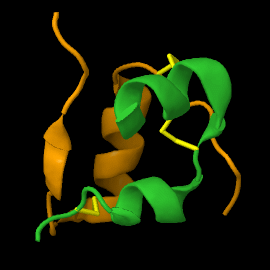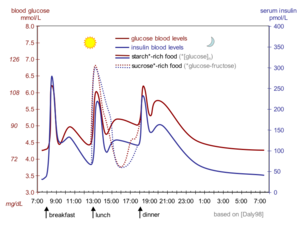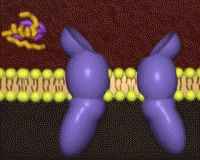Insulin
From Proteopedia
Insulin is a peptide hormone that helps to maintain blood sugar within a healthy range by regulating carbohydrate and lipid metabolism throughout the body. It is secreted by specialized cells in the pancreas and acts by binding to insulin receptors on other cells. Insulin in its mature form contains two peptide chains connected by disulfide crosslinks, and occurs either as monomer or as hexamer. Administering insulin in carefully determined doses at the appropriate times is used in managing diabetes, a chronic condition where the body fails to maintain blood sugar levels by itself.
- Proinsulin is the insulin precursor which is converted in the pancreas to insulin and C-peptide[1].
- Leginsulin is an insulin-like peptide found in legumes [2].
- Insulin lispro is recombinant insulin which has more rapid absorption than regular insulin[3]. See also Insulin lispro.
- Insulin glargine is a long-acting insulin [4]. See also Insulin glargine.
- Insulin detemir is a long-acting analog used for patients with type 1 or 2 diabetes [5].
- Insulin desB30 is an insulin with B chain lacking residue 30 (The) [6].
Contents |
Other Proteopedia pages about or relating to insulin
This page is for an audience with some basic knowledge of biochemistry. If you encounter terms you don't know, such as disulfide bond or hexamer, you are encouraged to look them up on Proteopedia or elsewhere. Sometimes, links are already provided, and sometimes a close look at the 3D figures will already give you an idea. Below are listed other pages on the topic, some more basic and some more detailed.
Diabetes & Hypoglycemia
Insulin (Hebrew)
Insulin aspart
Insulin and pro-insulin (Hebrew)
Insulin-Degrading Enzyme
Molecular_Playground/Insulin
Insulin Structure & Function
Insulin signal transduction pathway
Proteins that interact with insulin
Insulin Receptor UMAss
Insulin Receptor - kinase_domain (Hebrew)
Insulin receptor
Insulin-like growth factor receptor
Tutorials we would love to see
Tutorial: what molecules play a role in diabetes? (TBD)
Tutorial: how does insulin regulate my blood sugar? (TBD)
Function
Our blood sugar level (i.e. glucose concentration) varies over time with food intake and exercise, but has to remain in a narrow range so we stay healthy (not become hyperglycemic or hypoglycemic). Insulin, together with glucagon, regulates blood sugar levels by changing fuel metabolism in all metabolic cells (e.g. liver, fat, kidney, muscle and nerve cells) on a timescale of minutes and hours[7][8][9]. In simplest terms, the presence of insulin in the blood signals the well-fed stage, while the presence of glucagon signals the fasting stage.
Biosynthesis and processing of insulin occurs in the beta cells of the pancreas. The beta cells are found in the islets of Langerhans, which also contain the alpha cells that synthesize glucagon. Insulin is made as a 110 amino acid pre-proinsulin, which is processed to the mature 51 amino acid insulin and targeted to secretory vesicles. In a healthy adult, about 200 units of insulin are available in the pancreas, of which 30-50 units are secreted daily[10]. With a unit of insulin corresponding to 0.0347 mg mature insulin [11], the body contains only about 7 mg of insulin. In its stored form, insulin is a hexamer complexed to zinc ions.
Insulin is constantly released into the blood stream at a basal level. When blood glucose levels rise after a meal containing carbohydrates (sugars and starches), increased intracellular glucose in the beta cells triggers a series of processes that change the intracellular calcium concentration. First, the calcium concentration rises and stays elevated for 5-10 minutes, and then it spikes in intervals of roughly 3 minutes. Whenever calcium concentrations are high, insulin-containing vesicles merge with the plasma membrane, releasing insulin into the blood stream in the same temporal pattern as the calcium spikes[12]. The insulin is released into the bloodstream, where it first reaches the liver via the portal vein[13], and then the other organs after insulin-containing blood returns from the heart.
Once insulin binds to its receptor, the receptor is removed from the plasma membrane, insulin is degraded and the receptor is recycled[17]. The majority of insulin is removed from the bloodstream this way on its first pass through the liver. The half-life of insulin in the blood plasma is about about 4-6 minutes[18].
Disease and Treatment
In patients with diabetes, insulin signalling is compromised[19]. In type I diabetes, insulin is not produced sufficiently because the beta cells in the pancreas are absent or compromised by an autoimmune event. The onset of type 1 diabetes is rapid, and often occurs early in life ("juvenile diabetes"). In type II diabetes, insulin is secreted at normal or even elevated levels, but the target cells do not respond properly, for reasons not yet understood[20]. The onset of type 2 diabetes is gradual (over years), and there are warning signs (like insulin resistance) that in some cases helps to avert the onset by certain changes in lifestyle and diet[21].
Type 1 diabetes is managed by administering insulin. The challenge is to keep the blood sugar level in a healthy range while conditions change (food intake, exercise, illness). Insulin can not be given orally because it is broken down in the digestive tract. Instead, it is administered via subcutaneous depots or in other non-oral forms). There are long-acting and short-acting preparations of insulin to provide the basal level and to manage spikes in blood glucose levels, respectively. Type 2 diabetes is managed in a variety of ways, which may include administration of extra insulin to partially counteract the diminished signalling capacity.
Structure
| |||||||||||
Insulin 3D structures
See also
Insulin @RCSB
Insulin @Wikipedia
Insulin @PDBe
Diabetes @RCSB
References
- ↑ Kitabchi AE. Proinsulin and C-peptide: a review. Metabolism. 1977 May;26(5):547-87. PMID:403392 doi:10.1016/0026-0495(77)90099-3
- ↑ Hashidume T, Sakano T, Mochizuki A, Ito K, Ito S, Kawarasaki Y, Miyoshi N. Identification of soybean peptide leginsulin variants in different cultivars and their insulin-like activities. Sci Rep. 2018 Nov 15;8(1):16847. PMID:30442953 doi:10.1038/s41598-018-35331-5
- ↑ Wilde MI, McTavish D. Insulin lispro: a review of its pharmacological properties and therapeutic use in the management of diabetes mellitus. Drugs. 1997 Oct;54(4):597-614. PMID:9339963 doi:10.2165/00003495-199754040-00006
- ↑ Gillies PS, Figgitt DP, Lamb HM. Insulin glargine. Drugs. 2000 Feb;59(2):253-60; discussion 261-2. PMID:10730548 doi:10.2165/00003495-200059020-00009
- ↑ Keating GM. Insulin detemir: a review of its use in the management of diabetes mellitus. Drugs. 2012 Dec 3;72(17):2255-87. PMID:23110609 doi:10.2165/11470200-000000000-00000
- ↑ Wu J, Gong G, Han S, Zhang W, Hu Y, Xie L. Expression, purification, and characterization of the Degludec precursor DesB30. Protein Expr Purif. 2019 Sep;161:28-39. PMID:31039402 doi:10.1016/j.pep.2019.04.010
- ↑ https://www.yourhormones.info/hormones/insulin/
- ↑ Sonksen P, Sonksen J. Insulin: understanding its action in health and disease. Br J Anaesth. 2000 Jul;85(1):69-79. PMID:10927996
- ↑ Weiss MA, Lawrence MC. A thing of beauty: Structure and function of insulin's "aromatic triplet". Diabetes Obes Metab. 2018 Sep;20 Suppl 2:51-63. doi: 10.1111/dom.13402. PMID:30230175 doi:http://dx.doi.org/10.1111/dom.13402
- ↑ https://www.britannica.com/science/insulin
- ↑ https://www.who.int/biologicals/expert_committee/BS_2143_Human_Recombinant_Insulin_final.pdf
- ↑ Henquin JC. Regulation of insulin secretion: a matter of phase control and amplitude modulation. Diabetologia. 2009 May;52(5):739-51. doi: 10.1007/s00125-009-1314-y. Epub 2009, Mar 14. PMID:19288076 doi:http://dx.doi.org/10.1007/s00125-009-1314-y
- ↑ "https://www.diabetesselfmanagement.com/diabetes-resources/definitions/portal-vein/"
- ↑ https://pdb101.rcsb.org/motm/182
- ↑ 15.0 15.1 Gutmann T, Kim KH, Grzybek M, Walz T, Coskun U. Visualization of ligand-induced transmembrane signaling in the full-length human insulin receptor. J Cell Biol. 2018 May 7;217(5):1643-1649. doi: 10.1083/jcb.201711047. Epub 2018, Feb 16. PMID:29453311 doi:http://dx.doi.org/10.1083/jcb.201711047
- ↑ http://www.vivo.colostate.edu/hbooks/pathphys/endocrine/pancreas/insulin_phys.html
- ↑ Haeusler RA, McGraw TE, Accili D. Biochemical and cellular properties of insulin receptor signalling. Nat Rev Mol Cell Biol. 2018 Jan;19(1):31-44. doi: 10.1038/nrm.2017.89. Epub 2017 , Oct 4. PMID:28974775 doi:http://dx.doi.org/10.1038/nrm.2017.89
- ↑ Duckworth WC, Bennett RG, Hamel FG. Insulin degradation: progress and potential. Endocr Rev. 1998 Oct;19(5):608-24. doi: 10.1210/edrv.19.5.0349. PMID:9793760 doi:http://dx.doi.org/10.1210/edrv.19.5.0349
- ↑ https://www.endotext.org/section/diabetes/
- ↑ Samuel VT, Shulman GI. The pathogenesis of insulin resistance: integrating signaling pathways and substrate flux. J Clin Invest. 2016 Jan;126(1):12-22. doi: 10.1172/JCI77812. Epub 2016 Jan 4. PMID:26727229 doi:http://dx.doi.org/10.1172/JCI77812
- ↑ doi: https://dx.doi.org/10.1530/endoabs.56.PL5
- ↑ Davidson HW. (Pro)Insulin processing: a historical perspective. Cell Biochem Biophys. 2004;40(3 Suppl):143-58. PMID:15289650
- ↑ https://en.wikipedia.org/wiki/C-peptide
- ↑ doi: https://dx.doi.org/10.1101/679233
- ↑ Menting JG, Yang Y, Chan SJ, Phillips NB, Smith BJ, Whittaker J, Wickramasinghe NP, Whittaker LJ, Pandyarajan V, Wan ZL, Yadav SP, Carroll JM, Strokes N, Roberts CT Jr, Ismail-Beigi F, Milewski W, Steiner DF, Chauhan VS, Ward CW, Weiss MA, Lawrence MC. Protective hinge in insulin opens to enable its receptor engagement. Proc Natl Acad Sci U S A. 2014 Aug 4. pii: 201412897. PMID:25092300 doi:http://dx.doi.org/10.1073/pnas.1412897111
- ↑ Scapin G, Dandey VP, Zhang Z, Prosise W, Hruza A, Kelly T, Mayhood T, Strickland C, Potter CS, Carragher B. Structure of the Insulin Receptor-Insulin Complex by Single Particle CryoEM analysis. Nature. 2018 Feb 28. pii: nature26153. doi: 10.1038/nature26153. PMID:29512653 doi:http://dx.doi.org/10.1038/nature26153
Proteopedia Page Contributors and Editors (what is this?)
Karsten Theis, Michal Harel, Alexander Berchansky, Jaime Prilusky, David Canner




